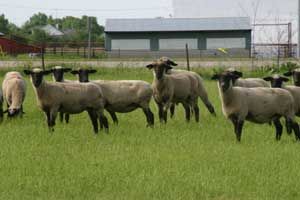Sore mouth can be a problem for sheep and goats

As spring season progresses, more livestock producers will be hosting various club lamb and show goat sales. As animals from different producers comingle for the first time at their new homes, the opportunity for disease transmission increases greatly. However, one infectious disease that might be overlooked by sheep and goat owners is Orf Virus, better known as sore mouth. Orf Virus is one disease that can be transmitted to humans, and it affects 15% of sheep and 8% of goats in the world. The disease is caused by a virus from the Poxviridae Family and has been reported by sheep and goat producers since the late nineteenth century.
Sheep and goats that are infected with Orf Virus will develop scabs and sores on their muzzle, lips, and inner mouth. Early into the infection, the sores will appear to look like blisters and then will develop into crusted scabs. Infections will clear up within a month and do not typically cause any major issues. However, if the sores are inside the mouth, the lamb or goat may reduce food intake causing slower gain. Initial gain can really impact the animal’s success at spring shows and can impact their likelihood for making weight at county fairs.
Orf Virus is easily transmitted between animals through any direct contact with a bodily fluid that contains virus whether it be nose-to-nose or body-to-body. Waterers, feed-buckets, blankets, muzzles, and halters are easy sources for contamination. As the scabs on the mouth and body heal, the scabs will dry up and fall off as the skin below the scab heals. The scab can fall off and the virus can enter the soil or bedding in the environment. The virus is extra hardy when it is in the scab and can live in the environment for months or even years. This means that pastures, bedding, waterers, feed troughs, and halters that have scab materials on them can be dangerous for uninfected animals for long periods.
Since Orf Virus is mostly contracted through open wounds, it is important to reduce the likelihood of cuts to the mouth where the virus can enter. This can be done by removing thistle or abrasive brush from grazing areas. Frequently disinfecting feed troughs and buildings where animals frequently gather is another important measure to take. And like with many other diseases, it is always important to quarantine new animals to ensure that an infection is not present. Humans should also wear gloves and wash their hands frequently when caring for an animal that has visible sores on their muzzle, lips, or inner mouth to avoid Orf Virus transmission to themselves.
When the virus is spread to humans, it will appear in the form of sores or wart like bumps on the hands. It is commonly transmitted to humans through common practices that come with owning sheep and goats. Tube or bottle feeding, sheering or clipping, and handling infected equipment like a feed pan or harness are all common sources of transmission to humans. Infections in humans are not serious in most cases and tend to clear up within six weeks. A mild fever and fatigue may also accompany the sores. It is very important for people with sores to keep them covered and clean to avoid a further infection.
Although Orf Virus is not a life-threatening disease, it is important for sheep and goat owners to still be aware of the disease to avoid the discomfort that is associated with the infection for both themselves and their animals. One of the greatest responsibilities of livestock producers is to ensure that disease does not enter their herd or leave their farm and pose a risk to other operations. If your animal has sores be sure to avoid going to shows or encountering other animals. Spring shows and sales can be a fun time for 4-H and FFA members and their families. It also can be a risky time for disease transmission. Being aware of threats, big or small, is a great way to protect animals and people everywhere.


